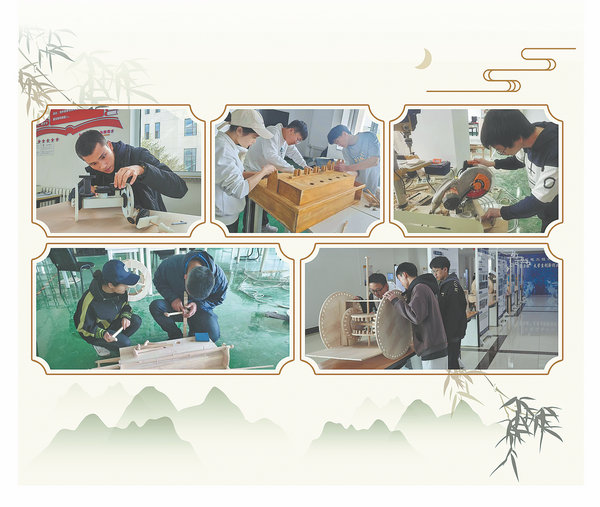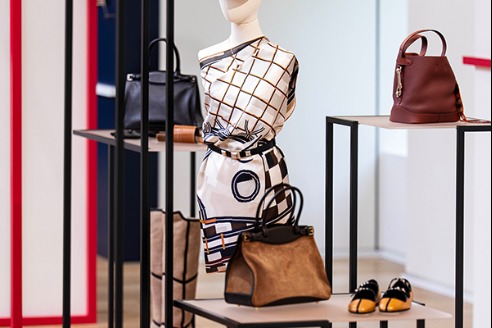The past instructing the present


The hidden excellence of Chinese ancient technology finds a new renaissance through a unique educational and cultural project at Dalian Minzu University.
More than 20 restored models of ancient Chinese mechanical inventions are currently on display in the lobby of the College of Mechanical and Electrical Engineering at Dalian Minzu University in Dalian, Northeast China's Liaoning province, attracting many students and teachers to visit and share photos on social media.
Visitors not only marveled at the breadth and depth of traditional Chinese culture but also praised the refinement of the restored models, including the guide vehicle, waterwheel, and vertical-axis windmill. These models were meticulously crafted by students under the guidance of teachers from the college.
A group of five students, including Delaram Nurmemet, a 20-year-old junior majoring in intelligent manufacturing, worked together to recreate the lianji shuidui, a traditional water-powered grain processing tool used to crush grains. Their work won a first prize in the awards at the end of the project.
"We referred to a lot of text, pictures, and video materials, and combined the professional knowledge we learned in class. Nevertheless, the process was not easy," said Nurmemet, adding that she could feel the wisdom of ancient Chinese people and, in particular, admired their imagination and hands-on abilities.
She and her group mates began by thoroughly researching the historical background of the invention of the machine, the production methods of the time, and the way of life of people during that era. They also delved into the principles of mechanics and their functions. Using the engineering drawing techniques they had acquired, they created 2D computer drawings to accurately depict the internal structure of the ancient equipment and the dimensions of each production component.
Following their teachers' guidance, they then proceeded to measure, cut, polish, and assemble the components, step by step.
"Although we started from scratch, we built such a machine ourselves in just over 20 days! Now, I can even do some simple woodworking, which is amazing!" she recalled.
Nurmemet, who came to study in Dalian from Kashgar in the Xinjiang Uygur autonomous region of Northwest China, said the group members are from different regions and ethnic backgrounds. They deepened their friendships while studying and working together.
Gao Tianyi, the deputy dean of the college, emphasized the importance of integrating traditional Chinese culture with professional education to promote traditional culture and enhance students' understanding of it. Therefore, the college organized a series of activities related to the restoration of ancient Chinese mechanical models as part of an innovation and entrepreneurship competition. Within a week of announcing the activity, more than 30 student groups registered to participate in the program.
To provide comprehensive guidance and assistance, the college assigned theoretical and practical instructors and set up a temporary workshop with new equipment and tools. Students used modern technology and applied their professional knowledge to recreate ancient mechanical devices that date back thousands of years, such as irrigation tools, grain processing tools, meteorological instruments, and siege weapons.
"We often talk about promoting the 'craftsman spirit', but students often don't pay much attention to it. However, when they start working on something themselves, they take it very seriously," said Gao. He noted that many groups of students abandoned their holiday plans and continued working in the workshop during the May Day holiday.
"While some students enjoy playing video games and watching short videos in their spare time, this hands-on activity has brought them closer to their classmates. They've been enjoying working together, combining theory and practice while creating models," he added.
During the May Day holiday, Gong Yongwei, a teacher from the Engineering Education Center was present in the workshop to guide the student groups through the production process.
"We took safety precautions, especially because woodworking tools can be dangerous for inexperienced users," Gong emphasized.
Before starting production, he would review the students' designs and provide suggestions for revisions, while explaining key points and potential production challenges. He noted that due to installation gaps and other factors, the actual size of the finished product might differ from the design, requiring occasional adjustments.
Thanks to their hard work, the students successfully completed their models of ancient devices, showcasing the remarkable achievements in agriculture, water conservancy, and military technology from ancient China.
Li Tianzhe, a freshman at the time, and his teammates also received a first prize for their reconstruction of the guide vehicle, a tool used to indicate direction on ancient battlefields. They utilized software modeling, 3D printing, and workbench analysis to recreate the proportional model.
"The guide vehicle, called zhinan che, is composed of many gears. By controlling the transmission ratio between the gears, you can fix the pointing direction of the vehicle," said Li.
Li teamed up with the other three students in his dorm and another student from the next dorm. Since they are all vehicle engineering majors, they chose to make such a device.
"There was no prize money. We got only a certificate of commendation. But we were all so happy that we put the award certificate on the inside of our dorm door so we can see it every time we go out. The guy from the next dorm also comes to look at it from time to time," Li said.
The project incorporated a presentation and defense phase, allowing students to display their understanding and appreciation of traditional Chinese culture through the language of engineering.
Kang Lei, an instructor at the college, said the college plans to continue organizing similar projects in the future to encourage students to learn from each other and make progress together.
"The restoration project has not only provided students with hands-on learning experiences but also fostered their appreciation for traditional Chinese culture and enabled them to integrate theory and practice in their academic pursuits," he said.
For the next project, Li said he plans to find new teammates to collaborate on another interesting cultural and creative product.
Nurmemet, on the other hand, intends to team up with her previous partners again to enhance their initial grain processing tool.
"The previous one was powered by water, but the water source was not convenient during the demonstration, so we will make a motor-driven one," she said.




































